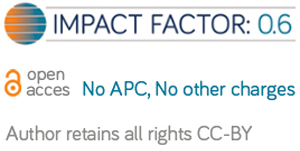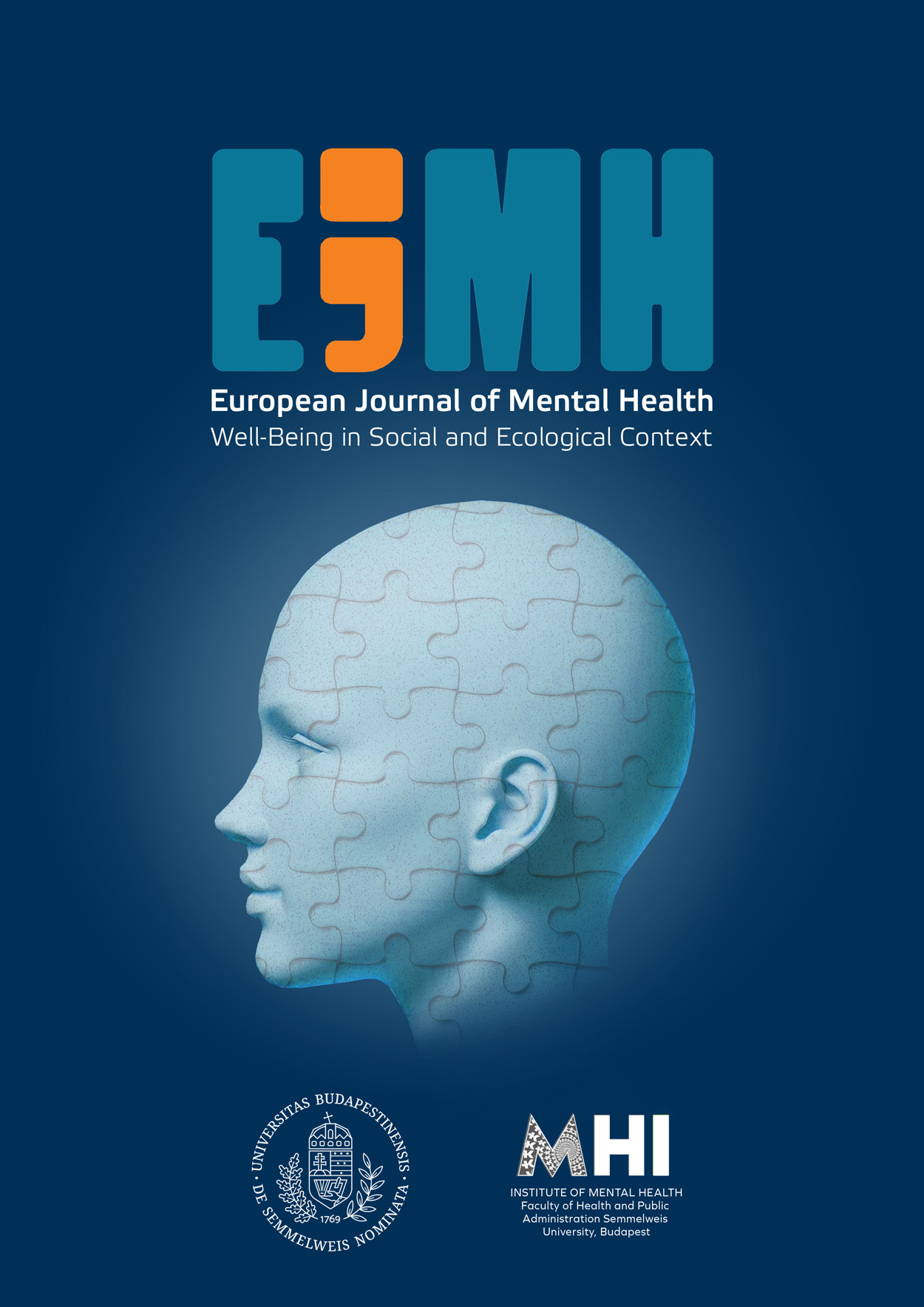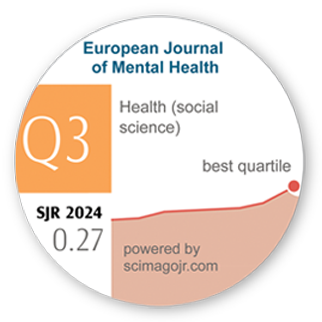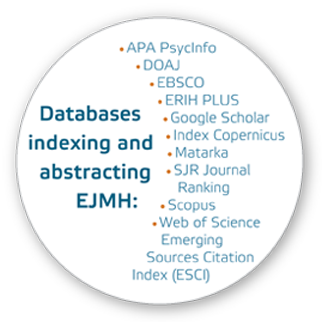From Family Conflicts to Suicide Risk Through Deliberate Self-Harm Online Content in Adolescents and Young Adults
DOI:
https://doi.org/10.5708/EJMH.19.2024.0030Keywords:
adolescents, deliberate self-harm, suicidal ideation, family conflicts, onlineAbstract
Introduction: Family conflicts are considered a risk factor for deliberate self-harm (DSH) and even suicidal thoughts and behaviors. Research also shows that adolescents are increasingly engaging in online DSH activities. However, studies on this topic are scarce.
Aims: This study’s first goal is to replicate the effect of family conflicts on suicidal ideation (SI) and, according to the gateway theory, include DSH diversity as a step preceding SI. Second, we aim to consider online activities in understanding suicidal risk. We start by describing online DSH activities, and propose a sequential mediation model in which family conflicts predict DSH and SI through online DSH activities.
Methods: The convenience sample of this cross-sectional study consisted of 357 adolescents and young adults between 12 and 22 years old who completed a self-report questionnaire measuring family conflicts, online DSH activities, identification with DSH-related content creators, DSH, and suicidal ideation.
Results: The results showed that 85.3% of our community sample used the internet for DSH-related purposes. Results also revealed an independent mediation effect of DSH diversity on the relationship between family conflicts and SI, and a sequential mediation effect of online DSH activities, identification, and DSH diversity.
Conclusions: Engaging in online DSH activities is only predictive of DSH or SI if adolescents perceive a shared identity with this community of creators. The findings might yield implications regarding the design of prevention strategies that include a further supervision of online platforms and psychological interventions that incorporate the family system and peers.
References
Adams, J., Rodham, K., & Gavin, J. (2005). Investigating the “self” in deliberate self-harm. Qualitative Health Research, 15(10), 1293–1309.
https://doi.org/10.1177/1049732305281761
Adler, P. A., & Adler, P. (2008). The cyber worlds of self-injurers: Deviant communities, relationships, and selves. Symbolic Interaction, 31(1), 33–56.
https://doi.org/10.1525/si.2008.31.1.33
Aggarwal, S., Patton, G., Reavley, N., Sreenivasan, S. A., & Berk, M. (2017). Youth self-harm in low- and middle-income countries: Systematic review of the risk and protective factors. International Journal of Social Psychiatry, 63(4), 359–375.
https://doi.org/10.1177/0020764017700175
Andover, M. S., & Gibb, B. E. (2010). Non-suicidal self-injury, attempted suicide, and suicidal intent among psychiatric inpatients. Psychiatry Research, 178(1), 101–105.
https://doi.org/10.1016/j.psychres.2010.03.019
Arendt, F., Scherr, S., & Romer, D. (2019). Effects of exposure to self-harm on social media: Evidence from a two-wave panel study among young adults. New Media and Society, 21(11–12), 2422–2442.
https://doi.org/10.1177/1461444819850106
Baker, D., & Fortune, S. (2008). Understanding self-harm and suicide websites a qualitative interview study of young adult website users. Crisis, 29(3), 118–122.
https://doi.org/10.1027/0227-5910.29.3.118
Baker, T. G., & Lewis, S. P. (2013). Responses to online photographs of non-suicidal self-injury: A thematic analysis. Archives of Suicide Research, 17(3), 223–235.
https://doi.org/10.1080/13811118.2013.805642
Bargh, J. A., Mckenna, K. Y. A., & Fitzsimons, G. M. (2002). Can you see the real me? Activation and expression of the “true self” on the internet. Journal of Social Issues, 58(1), 33–48.
https://doi.org/https://doi.org/10.1111/1540-4560.00247
Bell, J., Mok, K., Gardiner, E., & Pirkis, J. (2018). Suicide-related internet use among suicidal young people in the UK: Characteristics of users, effects of use, and barriers to offline help-seeking. Archives of Suicide Research, 22(2), 263–277.
https://doi.org/10.1080/13811118.2017.1334609
Biernesser, C., Sewall, C. J. R., Brent, D., Bear, T., Mair, C., & Trauth, J. (2020). Social media use and deliberate self-harm among youth: A systematized narrative review. Children and Youth Services Review, 116.
https://doi.org/10.1016/J.CHILDYOUTH.2020.105054
Blos, P. (1979). The adolescent passage. International Universities Press.
Branje, S. (2018). Development of parent–adolescent relationships: Conflict interactions as a mechanism of change. Child Development Perspectives, 12(3), 171–176.
https://doi.org/10.1111/cdep.12278
Brown, R. C., Fischer, T., Goldwich, A. D., Keller, F., Young, R., & Plener, P. L. (2018). #cutting: Non-suicidal self-injury (NSSI) on Instagram. Psychological Medicine, 48(2), 337–346.
https://doi.org/10.1017/S0033291717001751
Brown, R. C., Fischer, T., Goldwich, D. A., & Plener, P. L. (2020). “I just finally wanted to belong somewhere”- Qualitative analysis of experiences with posting pictures of self-injury on Instagram. Frontiers in Psychiatry, 11.
https://doi.org/10.3389/fpsyt.2020.00274
Campaioli, G., Sale, E., Simonelli, A., & Pomini, V. (2017). The dual value of the web: Risks and benefits of the use of the internet in disorders with a self-destructive component in adolescents and young adults. Contemporary Family Therapy, 39(4), 301–313.
https://doi.org/10.1007/s10591-017-9443-9
Cruz, D., Narciso, I., Pereira, C. R., & Sampaio, D. (2014). Risk trajectories of self-destructiveness in adolescence: Family core influences. Journal of Child and Family Studies, 23(7), 1172–1181.
https://doi.org/10.1007/s10826-013-9777-3
Dieserud, G., Gerhardsen, R. M., Van den Weghe, H., & Corbett, K. (2010). Adolescent suicide attempts in Bærum, Norway, 1984–2006: Trends, triggers, and underlying reasons. Crisis, 31(5), 255–264.
https://doi.org/10.1027/0227-5910/a000030
Duarte, E., Gouveia-Pereira, M., & Gomes, H. S. (2019). Development and factorial validation of the inventory of deliberate self-harm behaviours for Portuguese adolescents. Psychiatric Quarterly, 90(4), 761–776.
https://doi.org/10.1007/s11126-019-09660-1
Duarte, T. A., Paulino, S., Almeida, C., Gomes, H. S., Santos, N., & Gouveia-Pereira, M. (2020). Self-harm as a predisposition for suicide attempts: A study of adolescents’ deliberate self-harm, suicidal ideation, and suicide attempts. Psychiatry Research, 287.
https://doi.org/10.1016/j.psychres.2019.112553
Duggan, J. M., Heath, N. L., Lewis, S. P., & Baxter, A. L. (2012). An examination of the scope and nature of non-suicidal self-injury online activities: Implications for school mental health professionals. School Mental Health, 4(1), 56–67.
https://doi.org/10.1007/s12310-011-9065-6
Dyson, M. P., Hartling, L., Shulhan, J., Chisholm, A., Milne, A., Sundar, P., Scott, S. D., & Newton, A. S. (2016). A systematic review of social media use to discuss and view deliberate self-harm acts. PLoS ONE, 11(5), Article e0155813.
https://doi.org/10.1371/journal.pone.0155813
European Commission. (2020). Equity in school education in Europe. Structures, policies and student performance. Eurydice report. Publications Office of the European Union.
https://doi.org/10.2797/286306
Ferreira, J. A., & Castela, M. C. (1999). Questionário de ideação suicida (Q.I.S) [Questionnaire of suicidal ideation]. In L. Simões, M. Gonçalves, & L. Almeida (Eds.), Testes e provas psicológicas em Portugal (pp. 123–130). Apport/Sho.
Frost, M., & Casey, L. (2016). Who seeks help online for self-injury? Archives of Suicide Research, 20(1), 69–79.
https://doi.org/10.1080/13811118.2015.1004470
Frost, M., Casey, L., & Rando, N. (2016). Self-injury, help-seeking, and the internet: Informing online service provision for young people. Crisis, 37(1), 68–76.
https://doi.org/10.1027/0227-5910/a000346
Gámez-Guadix, M., Mateos, E., Wachs, S., & Blanco, M. (2022). Self-Harm on the internet among adolescents: Prevalence and association with depression, anxiety, family cohesion, and social resources. Psicothema, 34(2), 233–239.
https://doi.org/10.7334/psicothema2021.328
Gaspar, T., Guedes, F. B., Cerqueira, A., Matos, M. G., & Equipa Aventura Social. (2022). A saúde dos adolescentes portugueses em contexto de pandemia - Dados nacionais do estudo HBSC 2022 [The health of Portuguese adolescents in the context of the pandemic – National data from the HBSC 2022 study]. [Ebook].
https://aventurasocial.com/wp-content/uploads/2022/12/HBSC_Relato%CC%81rioNacional_2022-1.pdf
Giordano, A. L., Lundeen, L. A., Wester, K. L., Lee, J., Vickers, S., Schmit, M. K., & Kim, I. K. (2022). Nonsuicidal self-Injury on Instagram: Examining hashtag trends. International Journal for the Advancement of Counselling, 44(1).
https://doi.org/10.1007/s10447-021-09451-z
Gouveia-Pereira, M., Abreu, S., & Martins, C. (2014). How do families of adolescents with suicidal ideation behave? Psicologia: Reflexão e Crítica, 27(1), 171–178.
https://doi.org/https://doi.org/10.1590/S0102-79722014000100019
Gouveia-Pereira, M., Duarte, E., Gomes, H. S., da Silva, C. T., & Santos, N. (2022). Exploring the suicidal continuum: Deliberate self-harm diversity and severity as predictors of suicidal ideation and suicide attempts. Psychiatry Research, 309.
https://doi.org/10.1016/j.psychres.2022.114400
Grandclerc, S., De Labrouhe, D., Spodenkiewicz, M., Lachal, J., & Moro, M. R. (2016). Relations between nonsuicidal self-injury and suicidal behavior in adolescence: A systematic review. PLoS ONE, 11(4), Article e0153760.
https://doi.org/10.1371/journal.pone.0153760
Guan, K., Fox, K. R., & Prinstein, M. J. (2012). Nonsuicidal self-injury as a time-invariant predictor of adolescent suicide ideation and attempts in a diverse community sample. Journal of Consulting and Clinical Psychology, 80(5), 842–849.
https://doi.org/10.1037/a0029429
Guerreiro, D. F., Sampaio, D., Figueira, M. L., & Madge, N. (2017). Self-harm in adolescents: A self-report survey in schools from Lisbon, Portugal. Archives of Suicide Research, 21(1), 83–99.
https://doi.org/10.1080/13811118.2015.1004480
Gulbas, L. E., Hausmann-Stabile, C., De Luca, S. M., Tyler, T. R., & Zayas, L. H. (2015). An exploratory study of nonsuicidal self-injury and suicidal behaviors in adolescent Latinas. American Journal of Orthopsychiatry, 85(4), 302–314.
https://doi.org/10.1037/ort0000073
Hamza, C. A., Stewart, S. L., & Willoughby, T. (2012). Examining the link between nonsuicidal self-injury and suicidal behavior: A review of the literature and an integrated model. Clinical Psychology Review, 32(6), 482–495.
https://doi.org/10.1016/j.cpr.2012.05.003
Hawton, K., Saunders, K. E. A., & O’Connor, R. C. (2012). Self-harm and suicide in adolescents. The Lancet, 379(9834), 2373–2382.
https://doi.org/10.1016/S0140-6736(12)60322-5
Hayes, A. F. (2022). Introduction to mediation, moderation, and conditional process analysis: A regression-based approach (3rd ed.). The Guilford Press.
Jacob, N., Evans, R., & Scourfield, J. (2017). The influence of online images on self-harm: A qualitative study of young people aged 16–24. Journal of Adolescence, 60(1), 140–147.
https://doi.org/10.1016/j.adolescence.2017.08.001
Jetten, J., Haslam, S. A., Cruwys, T., Greenaway, K. H., Haslam, C., & Steffens, N. K. (2017). Advancing the social identity approach to health and well-being: Progressing the social cure research agenda. European Journal of Social Psychology, 47(7), 789–802.
https://doi.org/10.1002/ejsp.2333
Kalpakci, A., Venta, A., & Sharp, C. (2014). Beliefs about unmet interpersonal needs mediate the relation between conflictual family relations and borderline personality features in young adult females. Borderline Personality Disorder and Emotion Dysregulation, 1, Article 11.
https://doi.org/10.1186/2051-6673-1-11
Kim H. Y. (2013). Statistical notes for clinical researchers: Assessing normal distribution (2) using skewness and kurtosis. Restorative Dentistry & Endodontics, 38(1), 52–54.
https://doi.org/10.5395/rde.2013.38.1.52
Kline, R. B. (2005). Principles and practice of structural equation modeling (2nd ed.). Guilford Press.
Lavis, A., & Winter, R. (2020). #Online harms or benefits? An ethnographic analysis of the positives and negatives of peer-support around self-harm on social media. Journal of Child Psychology and Psychiatry and Allied Disciplines, 61(8), 842–854.
https://doi.org/10.1111/jcpp.13245
Lee, S. E., Yim, M., & Hur, J. W. (2022). Beneath the surface: Clinical and psychosocial correlates of posting nonsuicidal self-injury content online among female young adults. Computers in Human Behavior, 132.
https://doi.org/10.1016/j.chb.2022.107262
Lewis, S. P., & Baker, T. G. (2011). The possible risks of self-injury web sites: A content analysis. Archives of Suicide Research, 15(4), 390–396.
https://doi.org/10.1080/13811118.2011.616154
Lewis, S. P., Heath, N. L., Michal, N. J., & Duggan, J. M. (2012). Non-suicidal self-injury, youth, and the internet: What mental health professionals need to know. Child and Adolescent Psychiatry and Mental Health, 6(1), 13–21.
https://doi.org/10.1186/1753-2000-6-13
Lewis, S. P., & Seko, Y. (2016). A double-edged sword: A review of benefits and risks of online nonsuicidal self-injury activities. Journal of Clinical Psychology, 72(3), 249–262.
https://doi.org/10.1002/jclp.22242
Lin, M. P. (2020). Prevalence of internet addiction during the COVID-19 outbreak and its risk factors among junior high school students in Taiwan. International Journal of Environmental Research and Public Health, 17(22), Article 8547.
https://doi.org/10.3390/ijerph17228547
Logrieco, G., Marchili, M. R., Roversi, M., & Villani, A. (2021). The paradox of Tik Tok anti-pro-anorexia videos: How social media can promote non-suicidal self-injury and anorexia. International Journal of Environmental Research and Public Health, 18(3), Article 1041.
https://doi.org/10.3390/ijerph18031041
Madge, N., Hewitt, A., Hawton, K., Wilde, E., Corcoran, P., Fekete, S., van Heeringen, K., De Leo, D., & Ystgaard, M. (2008). Deliberate self-harm within an international community sample of young people: Comparative findings from the Child & Adolescent Self-harm in Europe (CASE) Study. Journal of Child Psychology and Psychiatry, 49(6), 667–677.
https://doi.org/10.1111/j.1469-7610.2008.01879.x
Marchant, A., Hawton, K., Stewart, A., Montgomery, P., Singaravelu, V., Lloyd, K., Purdy, N., Daine, K., & John, A. (2017). A systematic review of the relationship between internet use, self-harm and suicidal behaviour in young people: The good, the bad and the unknown. PLoS ONE, 12(8), Article e0181722.
https://doi.org/10.1371/journal.pone.0181722
Margherita, G., & Gargiulo, A. (2018). A comparison between pro-anorexia and non-suicidal self-injury blogs: From symptom-based identity to sharing of emotions. Psychodynamic Practice, 24(4), 346–363.
https://doi.org/10.1080/14753634.2018.1535326
Mesch, G. S. (2006). Family relations and the internet: Exploring a family boundaries approach. Journal of Family Communication, 6(2), 119–138.
https://doi.org/10.1207/s15327698jfc0602_2
Naz, A., Naureen, A., Kiran, T., Husain, O., Minhas, A., Razzaque, B., Tofique, S., Husain, N., Furber, C., & Chaudhry, N. (2021). Exploring lived experiences of adolescents presenting with self-harm and their views about suicide prevention strategies: A qualitative approach. International Journal of Environmental Research and Public Health, 18(9), Article 4694.
https://doi.org/10.3390/ijerph18094694
Nesi, J., Burke, T. A., Lawrence, H. R., MacPherson, H. A., Spirito, A., & Wolff, J. C. (2021). Online self-injury activities among psychiatrically hospitalized adolescents: Prevalence, functions, and perceived consequences. Research on Child and Adolescent Psychopathology, 49(4), 519–531.
https://doi.org/10.1007/s10802-020-00734-4
Nicolopoulos, A., Boydell, K., Shand, F., & Christensen, H. (2018). Why suicide? Reasons for suicide attempts as self-reported by youth: A systematic evaluation of qualitative studies. Adolescent Research Review, 3(2), 155–172.
https://doi.org/10.1007/s40894-017-0070-3
Nobre-Lima, L., Barreira, A., & Castilho, P. (2017). A influência de fatores sociodemográficos na expressão de comportamentos autolesivos não suicidários (NSSI) em adolescentes portugueses [The influence of sociodemographic factors in the expression of non-suicidal self-injury behaviors (NSSI) of Portuguese adolescents]. Journal of Child and Adolescent Psychology, 8, 33–48.
O’Brien, K. H. M., Nicolopoulos, A., Almeida, J., Aguinaldo, L. D., & Rosen, R. K. (2021). Why adolescents attempt suicide: A qualitative study of the transition from ideation to action. Archives of Suicide Research, 25(2), 269–286.
https://doi.org/10.1080/13811118.2019.1675561
Palmonari, A., Kirchler, E., & Pombeni, M. L. (1991). Differential effects of identification with family and peers on coping with developmental tasks in adolescence. European Journal of Social Psychology, 21(5), 381–402.
https://doi.org/10.1002/ejsp.2420210503
Pelkonen, M., & Marttunen, M. (2003). Child and adolescent suicide: Epidemiology, risk factors, and approaches to prevention. Paediatric Drugs, 5(4), 243–265.
https://doi.org/10.2165/00128072-200305040-00004
Reynolds, W. M. (1988). Suicide ideation questionnaire (SIQ). Psychological Assessment Resources.
Rodham, K., Gavin, J., & Miles, M. (2007). I Hear, I listen and I care: A qualitative investigation into the function of a self-harm message board. Suicide and Life-Threatening Behavior, 37(4), 422–430.
https://doi.org/10.1521/suli.2007.37.4.422
Santos, N. N., Monteiro, V., & Carvalho, C. (2023). Impact of grade retention and school engagement on student intentions to enrol in higher education in Portugal. European Journal of Education, 58(1), 130–150.
https://doi.org/10.1111/ejed.12535
Sands, R. G., & Dixon, S. L. (1986). Adolescent crisis and suicidal behavior: Dynamics and treatment. Child & Adolescent Social Work Journal, 3(2), 109–122.
https://doi.org/10.1007/BF00757218
Seko, Y., Kidd, S. A., Wiljer, D., & McKenzie, K. J. (2015). On the creative edge: Exploring motivations for creating non-suicidal self-injury content online. Qualitative Health Research, 25(10), 1334–1346.
https://doi.org/10.1177/1049732315570134
Sela, Y., Zach, M., Amichay-Hamburger, Y., Mishali, M., & Omer, H. (2020). Family environment and problematic internet use among adolescents: The mediating roles of depression and Fear of Missing Out. Computers in Human Behavior, 106, Article 106226.
https://doi.org/10.1016/j.chb.2019.106226
Seong, E., Noh, G., Lee, K. H., Lee, J. S., Kim, S., Seo, D. G., Yoo, J. H., Hwang, H., Choi, C. H., Han, D. H., Hong, S. B., & Kim, J. W. (2021). Relationship of social and behavioral characteristics to suicidality in community adolescents with self-harm: Considering contagion and connection on social media. Frontiers in Psychology, 12, Article 691438.
https://doi.org/10.3389/fpsyg.2021.691438
Simes, D., Shochet, I., Murray, K., & Sands, I. G. (2022). A systematic review of qualitative research of the experiences of young people and their caregivers affected by suicidality and self-harm: Implications for family-based treatment. Adolescent Research Review, 7(2), 211–233.
https://doi.org/10.1007/s40894-021-00164-3
Simone, A. C., & Hamza, C. A. (2020). Examining the disclosure of nonsuicidal self-injury to informal and formal sources: A review of the literature. Clinical Psychology Review, 82, Article 101907.
https://doi.org/10.1016/j.cpr.2020.101907
Steinberg, L. (2001). We know some things: Adolescent–parent relationships in retrospect and prospect. Journal of Research on Adolescence, 11(1), 1–19.
https://doi.org/10.1111/1532-7795.00001
Sternudd, H. T. (2012). Photographs of self-injury: Production and reception in a group of self-injurers. Journal of Youth Studies, 15(4), 421–436.
https://doi.org/10.1080/13676261.2012.663894
Suyemoto K. L. (1998). The functions of self-mutilation. Clinical Psychology Review, 18(5), 531–554.
https://doi.org/10.1016/s0272-7358(97)00105-0
Syed, E. U., & Khan, M. M. (2008). Pattern of deliberate self-harm in young people in Karachi, Pakistan. Crisis, 29(3), 159–163.
https://doi.org/10.1027/0227-5910.29.3.159
Tajfel, H., & Turner, J. (1979). An integrative theory of intergroup conflict. In W. G. Austim & S. Worchel (Eds.), Psychology of Intergroup Relations (pp. 33–47). Annual Reviews Inc.
Teodoro, M. L. M., Allgayer, M., & Land, B. (2009). Desenvolvimento e validade fatorial do Inventário do Clima Familiar (ICF) para adolescentes [Development and factorial validity of Family Climate Inventory (FCI) for adolescents]. Psicologia: Teoria e Prática, 11(3), 27–39.
Weymouth, B. B., Buehler, C., Zhou, N., & Henson, R. A. (2016). A meta‐analysis of parent–adolescent conflict: Disagreement, hostility, and youth maladjustment. Journal of Family Theory & Review, 8(1), 95–112.
https://doi.org/10.1111/jftr.12126
Whitlock, J. L., Powers, J. L., & Eckenrode, J. (2006). The virtual cutting edge: The internet and adolescent self-injury. Developmental Psychology, 42(3), 407–417.
https://doi.org/10.1037/0012-1649.42.3.407
Wright, M. F., Wachs, S., & Gámez-Guadix, M. (2021). Jóvenes ante el ciberodio: El rol de la mediación parental y el apoyo familiar [Youths’ coping with cyberhate: Roles of parental mediation and family support]. Comunicar, 29(67).
https://doi.org/10.3916/C67-2021-02
Zetterqvist, M., Jonsson, L. S., Landberg, Å., & Svedin, C. G. (2021). A potential increase in adolescent nonsuicidal self-injury during COVID-19: A comparison of data from three different time points during 2011 – 2021. Psychiatry Research, 305, Article 114208.
https://doi.org/10.1016/j.psychres.2021.114208
Zhu, L., Westers, N. J., Horton, S. E., King, J. D., Diederich, A., Stewart, S. M., & Kennard, B. D. (2016). Frequency of exposure to and engagement in nonsuicidal self-injury among inpatient adolescents. Archives of Suicide Research, 20(4), 580–590.
https://doi.org/10.1080/13811118.2016.1162240






